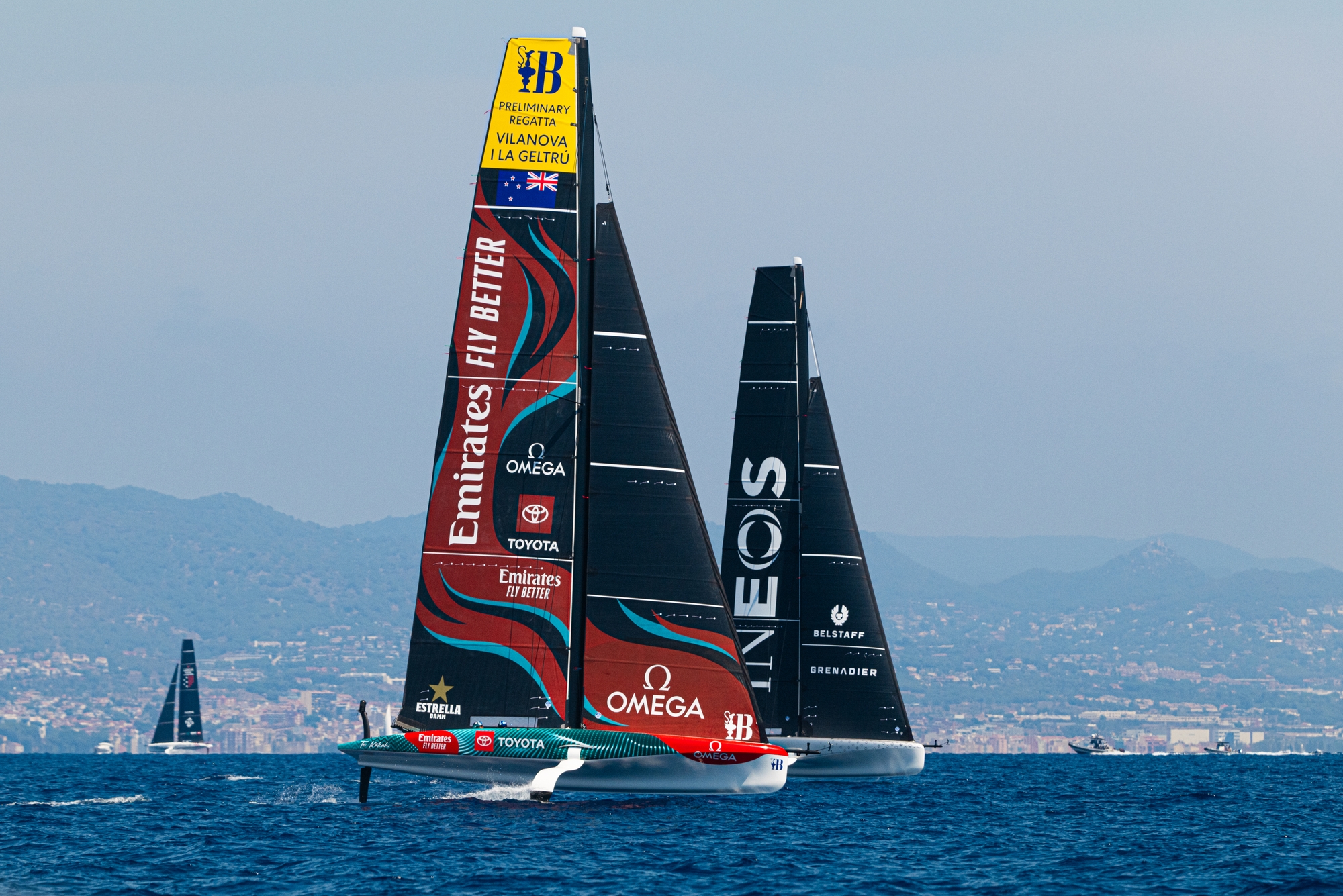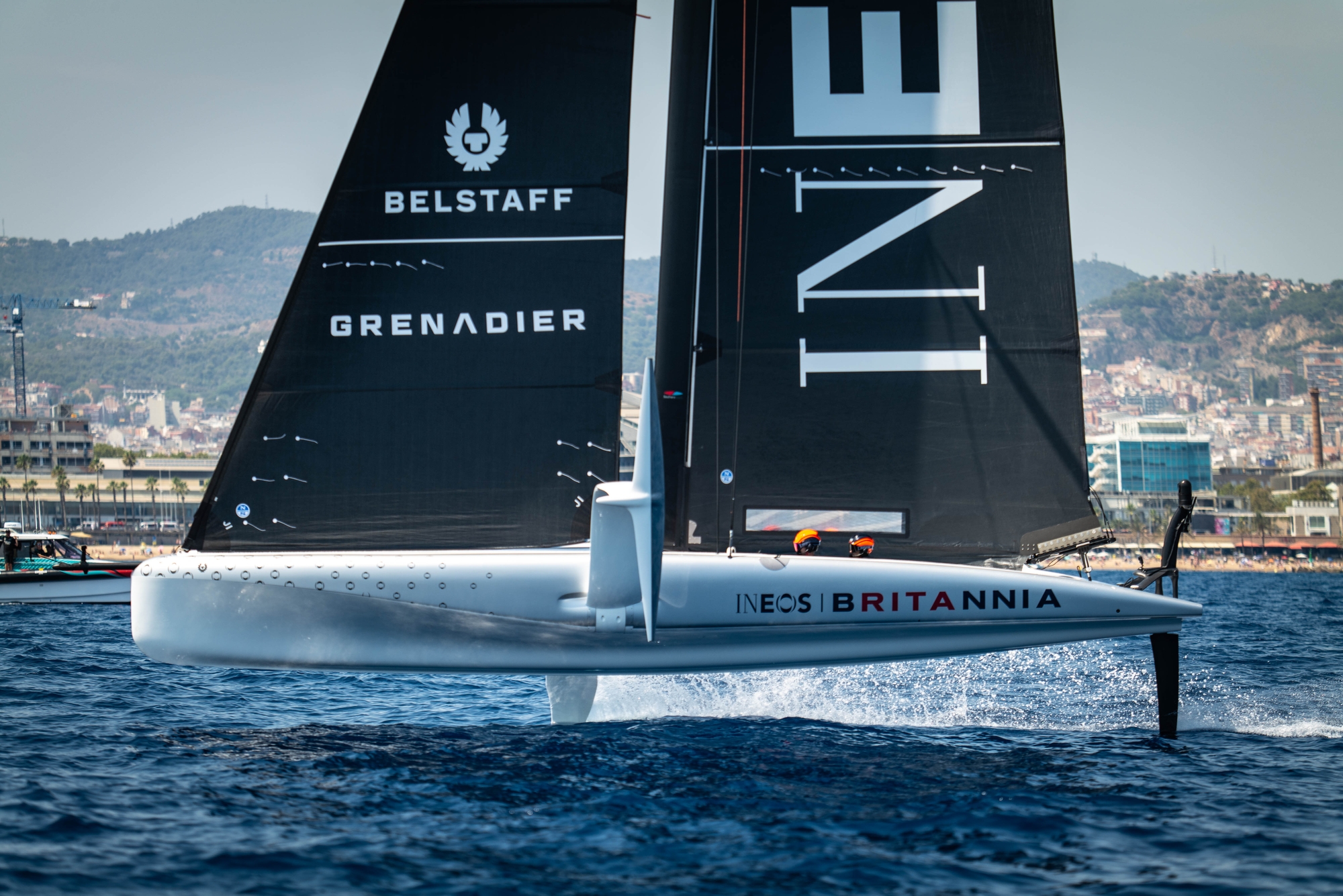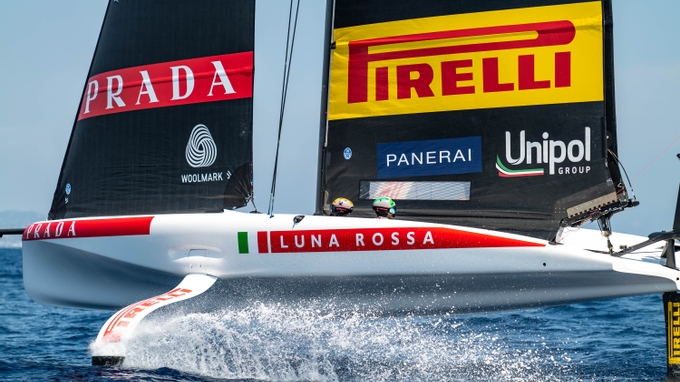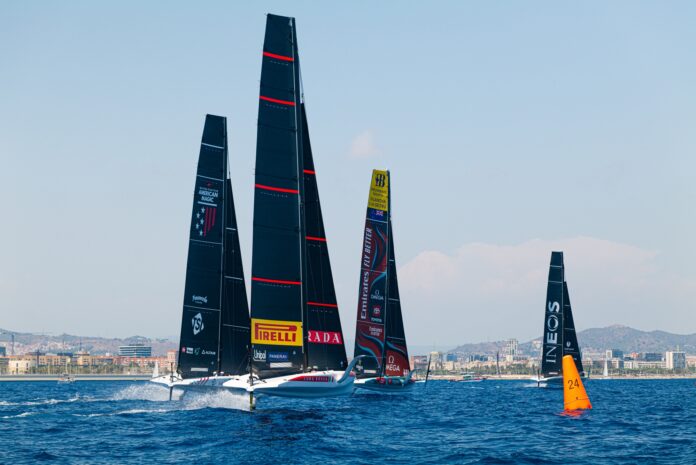It was day three of the race management, media and technology testing programme that again saw Emirates Team New Zealand, INEOS Britannia, NYYC American Magic and Luna Rossa Prada Pirelli come out to the America’s Cup racecourse for some test match-racing, and for the first time, a couple of all-in fleet races.
Barcelona’s been a windy and choppy venue of late. “It’s not normally like this,” opined a local Spanish photographer yesterday – and as sailors we’ve all heard that one before – but today it was more to the August summer mean with a beautifully calm sea state and a breeze that filtered in from the east but struggled to break double-digits before falling away into the hazy afternoon. These are the days where the team’s wind whisperers earn their keep, the trimmers with the deftest of touches are gold-dust and the smoothest helms are rewarded. Tough day – especially around the leeward mark that was the graveyard of many a good race.

The techniques that are developing in the AC40 fleet are fascinating. Ray Davies commented on the different ‘modes’ that teams were running yesterday in the bigger breezes and when the wind’s up, those are more obvious but in the lighter stuff, it’s nuanced with many different theories on show to keep flying. The call seems to be when to ride that little bit higher just as the zephyrs die and to co-ordinate trim to keep that crucial bit of power on at the right moment. It’s such a fine line and even the very best get it wrong. In one spectacular fleet race, Luna Rossa Prada Pirelli skipped away from the pack as they wallowed into desperate displacement, on another, the Kiwis just got richer and richer and looked to have found a completely different gear. If anyone thinks that the racing in Vilanova i La Geltrú in a few weeks’ time is going to be easy – think again. Consistency matters. A lot.

The format for the day was again to split into pairs with Emirates Team New Zealand and INEOS Britannia lining up on one course and Luna Rossa Prada Pirelli and NYYC American Magic on another. Picking form was an art and every team showed flashes of brilliance alongside episodes that their coaches and Team Principals will pore over with itchy chins. The Recon Unit for INEOS Britannia observed: “There was very little to choose between the two boats upwind or downwind in terms of straight-line speed but from our vantage point, the New Zealand crew’s boat handling just looked that little bit crisper at times in terms of the stability and speed out of manoeuvres.”
Meanwhile over on the Italy vs America course, it was the Italians on ‘Luna Rossa’ led by Jimmy Spithill and Francesco Bruni that looked super-slick today and forced errors into the playbook of Tom Slingsby and Paul Goodison on ‘Magic’ that saw them effectively score a 2-1 over the three early match – ‘races’ that were either concluded or abandoned.

After the separate racing, Iain Murray, Regatta Director, brought all four teams together for the showpieces of the day, desperate to get a couple of practice races in before the breeze shut down. This was the first time we have seen a fleet of AC40s racing together and the spectacle didn’t disappoint. The premium on starting, holding a lane and then working into the race was very much on show – atypical of one-design racing the world over – and with almost zero passing lanes being offered up, the rich typically got richer. Find a lifting puff that gives you position or any slight advantage and these sailors just capitalise like banshees. Emirates Team New Zealand did exactly that in the first fleet race and looked sensational, imperious even, but come the second race, and a woefully late start after nearly falling off their foils upwind on the lead back to the line and the Defenders went from hero to zero, unable even for them to get back into the race. The speed of the AC40s amplifies mistakes or judgement errors. It’s a brutal business, with no hiding places, conducted at break-neck speeds – even in the light airs.

After racing there were some terrific interviews to digest with all of the teams taking away ‘learnings’ but hugely grateful for the opportunity to line-up, perhaps not in anger, but in a spirit of ‘friendly competition between foreign nations’ – a line that George Shuyler demanded in the original Deed of Gift of 1857. It won’t stay like that come Vilanova i La Geltrú in September where the gloves will come off and all six teams will be competing – as an aside it’s great to see that the French ‘Orient Express Team’ now has taken delivery of their AC40 in Barcelona and will be sailing in a matter of days.
The mind games have started though, with Jimmy Spithill keen to take his preferred underdog position saying matter-of-factly: “I think we will just have to wait and see what happens in Villanova. Again for us we’re playing catch up you know, we just don’t have the time of the other teams in two boating or being around another AC40 so we’ve always been focussed pretty hard on our development boat and so we’ve just got a lower hour count on the 40 so we’re just trying to get as many as we can. I’m really observant of what the other guys are doing, and we’ve got a long way to go. We’ve got quite a lot to learn.”

Luna Rossa Prada Pirelli have looked brilliant on the water in the past two days. Always in the mix and often right at the front, their smooth techniques and wonderful handling have got everyone animated. Jimmy sees it as a real combination saying: “I think it was one of those days where everyone had some good moments and bad moments and again until you really get around some other boats, you know there’s a lot to learn just little technique differences, really watching what the others are doing. Again we’ve been really focusing pretty hard on the teams that have been doing a lot of two-boating with their AC 40s – being the Kiwis and the Americans – and yeah just try to learn as much as we could going into today…The hardware is exactly the same as the others and so it really just comes down to the teams using the controls you know – cant, ride height, the trim of the boat and obviously sail techniques, so there’s a lot of little things there and I think the whole fleet is just learning.”
Terry Hutchinson struck a more long-term view, very much with his eyes on the ultimate prize and returning the America’s Cup back to the New York Yacht Club who held the trophy from 1851 through to 1983. Terry broad-scoped saying: “So we entered at the beginning of 2022, so I feel like we’ve been racing ever since then. This is just part of the milestone of it and yeah I mean it’s good to have the boats out sailing, racing against each other, we’ve had a couple good days with Luna Rossa and then we did a couple of races today which were good as in the race committee team worked out the kinks and the bugs between the media system and getting some of the autonomous marks in a spot that everything is functional. So I think for American Magic we have 15 months to get ourselves ready for the Challenger Series and the Americas Cup, so each one of these opportunities you take and at the same time you know the lessons learned are building the foundation for our team.”

Those foundations would appear solid. The Americans are sailing super-hard day after day and really honing their modes and techniques into a real force in this America’s Cup cycle as was proven yesterday. Today was tough, but Terry struck an optimistic cord saying: “We have 15 months to develop a streamlined communication through incredibly talented sailors that know the right thing to do but have to learn each other, and so I’m always impressed at the demeanour that the guys have when they’re racing the boat, not so much today, but yesterday when it was windy and we’re on the J3s and we’re bearing away and the boats are sailing to the high 40s, you know it’s always impressive how flat-lined the guys are when they’re on the boat, it’s really, really, good. Today was a much harder day than yesterday and so it’s good to see where we’re weak and where we’re strong and that’s how we learn.”
Leigh McMillan cut a considered tone looking at the three days that they’ve spent tuning up with Emirates Team New Zealand saying: “Generally with the three days, we felt pretty strong so there’s nothing there that we want to throw our tuning guide in the bin, I think certainly getting into the dirty air in the light, getting into those moments, maybe moding the boat for the very bottom end of the range is something, the one area we’ve got to look at.”

However, for INEOS Britannia, the AC40 programme clearly has not been their main priority with the development work on their LEQ12 ‘T6’ taking centre stage as Leigh confirmed saying: “We’re certainly going to put some more time on the boat (the AC40) than we have up to now but it’s still not our primary focus, the Cup itself and designing and having a fast boat for the America’s Cup has got to be our absolute goal, but sure as we get closer to the event (in Vilanova) there will be a few more training days, I think there’s another one of these weekends set up as well where we will be racing against other teams, but ultimately the goal is the America’s Cup, so it’s not all about the AC40 for now.”
Pete Burling, skipper on Emirates Team New Zealand who stayed out practicing in the super-light conditions for some 45 minutes after all the racing had concluded, saw the three days as highly valuable saying: “It’s been amazing to see the progression of the systems over the three days you know from virtually everything getting bolted on the boat under a week ago to you know testing the systems the first time. Every day we’ve had huge steps forward, there’s obviously still a little bit to go but it’s been amazing to see the progression so far.”

Talking through the fleet racing, Pete summed up the day saying: “The first start we had really nice conditions there’s probably nine knots or something like that so you don’t have to worry too much about the wind shadows you could kind of manoeuvre anywhere and we did a nice job putting the right good spot and then the second one we actually ended up almost coming off the foil in a manoeuvre that 5 minutes out to start and barely made it back in time so we were right on the back foot the whole way and it was hard to get back into the race. It definitely wasn’t really our intention to start on port, but we just got a little bit too late and in that dying breeze I think we saw everyone apart from Prada off the foil at the end and not actually finishing the race. It’s pretty tricky when it gets below that seven knots to keep these boats going especially when you’re crossing the wind shadows. It’s great practise you know they’re a super tough conditions and we’re really excited to be out there racing other teams.”
Fantastic three days here in Barcelona. Plenty learned by all the teams and also by the race management, media and technology suppliers. Boxes were ticked all round but an early pecking order for Vilanova i La Geltrú is starting to form. One thing we know for sure – it will be desperately tight, and consistency is the name of the AC40 game.
On-Water Recon Unit Notes – INEOS Britannia: The third day of the special racing session saw INEOS Britannia once again paired up with Emirates Team New Zealand for the match racing section of the day. After leaving the harbour at 1145 the British crew – helmsmen Ben Ainslie and Giles Scott with trimmers / flight controllers Leigh McMillan and Bleddyn Mon – spent an hour and a half in free practice, initially on their own and then in tandem with the New Zealand team, with the breeze peaking at just eight knots and a flat sea state.

As in the previous two days there was very little to choose between the two boats upwind or downwind in terms of straight-line speed but from our vantage point, the New Zealand crew’s boat handling just looked that little bit crisper at times in terms of the stability and speed out of manoeuvres. When the official match racing started the pair sailed two partial races. In the first at 1330 the Kiwis came in port and led off start line. The teams ignored the windward mark, sailing well past it before the Kiwis bore away first to round the leeward gate well ahead and stop.
The second ‘race’ saw the British enter on port and chase the NZL team to the far right (looking upwind) of the start box before tacking in front of them to lead back to the line on starboard. The British led at the windward mark and leeward gate by 10 seconds. The teams stopped shortly after starting the second beat at 1410.
In the first of the two fleet races NZL led off the start-line from USA and ITA (who were the first to tack away to the right). GBR made a late start and were never really in contention. NZL led around the first mark and went on to win the race easily. USA rounded second finished second but were under constant pressure from ITA who closed the gap steadily throughout the race.
The second race saw USA lead from ITA at the top mark with GBR in third. NZL had been a late starter after coming in on their own from the left end of the line and rounded fourth. With the breeze dropping to 5-6 knots the teams were gybing through huge angles to try to stay on the foils. Only the Italians managed to make it to the leeward gate with the other three dropping off their foils.
Time was called on the day at 1545 but the British team stayed out for some extra free practice after being towed onto their foils. The team docked in at 1700. No sailing is scheduled for tomorrow (Sunday August 13) but the team plans to sail the following day (Monday) in their T6 LEQ12 test boat.
On-Water Recon Unit Notes – NYYC American Magic: Second day of racing between teams that was cut short because of the dying breeze. Magic docked-out @10:30h with Paul Goodison, Tom Slingsby, Michael Menninger and Riley Gibbs onboard who were greeted by a marginal wind of 6-8kt @110º with a sea state 2 so they hoisted jib#1 and went for a 26’ warm-up initial drill on their own. LRPP joined as planned and attempted a first race @12:20h. Magic on the lee won that start and was still leading on the first run when LRPP dropped off the foils and killed that 1 lap race.

They stopped briefly and had to be tow assisted to take off to start Race2 @12:58h. Magic started at the pin end and LRPP mid-line with a big gap between them both on stb tack. Right at the first crossing LRPP managed to slam tack in front of Magic, for the rest of the 2 laps race LRPP kept a tight cover giving Magic no options to overtake. Besides, rounding up at the bottom gate of the first lap Magic ventilated and fell further behind. Race 3 started @13:43h with LRPP at the pin end and Magic in the middle who ventilated right when crossing the start line. This gave the lead and enough advantage to LRPP to keep again a tight cover on Magic who could only trail behind for the rest of the 2 laps.
Next came FLEET RACE 1 in which everyone got invited. They started @14:45h with LRPP to windward and Magic on her lee very tight together, next on the lee was ETNZ a boat length ahead of them and INEOS Britannia further down the line but very late to the start. It looked like ETNZ was slightly OCS, or everyone else slightly late. First crossing was to Magic who had gone further to the right, but it was ETNZ who got the lead at the top gate and never gave it away, actually extending the gap to the other boats for the remainder of the 2 laps. LRPP and Magic got to the top mark overlapped with Magic outside and put a nice fight on the first run until Magic dropped off the foils in a tight crossing with LRPP who had right of way. Positions didn’t change from then on and INEOS Britannia kept losing behind the other boats to finish very last. The race was comfortably won by ETNZ, next was LRPP followed close by Magic and last INEOS Britannia miles behind.
A FLEET RACE 2 was started @15:30h with ETNZ unexpectedly late on port tack at the pin end, IB stb tack alone mid-line and Magic and LRPP to windward close together having their own fight. In this first upwind Magic played the shifts or the pressure better than the rest and was leading at the top gate followed closely by LRPP, next IB and then ETNZ far behind. But the wind was dying and eventually every boat dropped off the foils on the first run except for LRPP who kept foiling to finish alone this first lap miles ahead of a drifting fleet.
With just 4-6kt @160º wind they called it a day. Dock in for Magic was @16:16h. Lea Sitjà, Recon Unit NYAM.
On-Water Recon Unit Notes – Emirates Team New Zealand: ETNZ rolled out their only AC40 in Barcelona from the shed at 10.20 on one-design configuration. The boat was craned to the water at 11:00 and the team docked out at 11.45, as planned. The main and the J1 were hoisted at 11:55 and 12:02, respectively, inside the harbour. No sail changes were performed on the entire day.

To begin with, for approximately one hour, some speed tests were carried out sailing upwind with team INEOS Britannia. ETNZ positioned to windward and INEOS to leeward on starboard tack. On those speed tests, the Kiwis were slightly higher and faster and more consistent on their tacks. However, since the pressure was not the same everywhere and given that the boats were far away enough from each other in order to be on different winds, the confidence level of those speed testings is not extremely reliable.
At 13:30 the first of two match racing races with team INEOS got underway. One of the main goals of the day was to test the tactical software and some pending race management system aspects from the previous days. A set of pre-established series of situations were organized such as early entries to the start box, starting early over the line, sailing past the lay line boundaries, and getting penalties. None of those two races were completed.
Nevertheless, ETNZ had a better start on the first one and lead most of the way, while INEOS did it on the second one.
After those races, at 14:30 approximately, LRPP and AM joined to run two fleet races. A two-lap upwind-downwind racecourse with leeward gates, but with only one upwind mark was set. For the first race conventional marks were used, while on the second robotic marks came in replacement.
On the first race, ETNZ had the best start and was able to lead and extend during the entire race without almost any mistakes. LRPP finished 2nd on a close finish and after tight racing during most of the race with AM. INEOS was 4th.
On the second fleet race, ETNZ crossed the starting line late on port tack behind the rest of the fleet as a consequence of a bad manoeuvre during the last minute falling from their foils, that completely changed their starting plan and time-distance approach. The distance after the start was considerable and they were not able to recover in the entire race.
In a dying breeze, LRPP was the only one to be able to finish the race foiling, finishing 1st; while the rest fell-off from their foils on the last downwind and ended up sailing in displacement mode or trying to take-off with almost 180 degrees differences in their courses in between the two tacks.
After the races, ETNZ stayed for another 45 minutes training on their own doing some tacks and gybes in marginal wind conditions. A couple tows were needed to take-off in some opportunities.
Sails were lowered outside the port at 16:55, the boat was back in the dock at 17:05, craned out at 17:32 and back in the shed at 17:58.

UGO FONOLLÁ / AMERICA’S CUP

UGO FONOLLÁ / AMERICA’S CUP

©PAUL TODD/AMERICA’S CUP



















